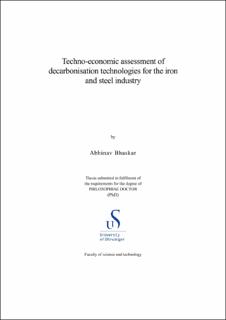| dc.contributor.advisor | Assadi, Mohsen | |
| dc.contributor.author | Bhaskar, Abhinav | |
| dc.date.accessioned | 2023-06-12T09:33:54Z | |
| dc.date.available | 2023-06-12T09:33:54Z | |
| dc.date.issued | 2023 | |
| dc.identifier.citation | Techno-economic assessment of decarbonisation technologies for the iron and steel industry by Abhinav Bhaskar, Stavanger : University of Stavanger, 2023 (PhD thesis UiS, no. 704) | en_US |
| dc.identifier.isbn | 978-82-8439-169-4 | |
| dc.identifier.issn | 1890-1387 | |
| dc.identifier.uri | https://hdl.handle.net/11250/3070917 | |
| dc.description.abstract | Rapid decarbonisation of all segments of the economy is essential to limit the global mean surface temperature rise to 1.5ºC. Industries contribute to approximately a quarter of the global energy related emissions but have not received the same level of attention as the power and transport segment. The heterogeneity of industrial processes, use of fossil fuels as chemical feedstock and source of high-temperature heat, and the competitive nature of global commodity markets makes it difficult to implement decarbonisation solutions. Improving energy efficiency of existing processes has been the primary focus to reduce emissions from the industrial processes and has led to significant decline in energy and emission intensity of industrial segments.
Approximately 1.8 billion tonnes of steel is produced every year globally. The iron and steel industry is the backbone of modern civilization and is indispensable for the development of robust and resilient infrastructure, and the production of automobiles, buildings, household appliances etc. Primary production of steel through the blast furnace basic oxygen furnace route has high energy and emission intensity. The steel industry contributes to 7-8% of the global greenhouse gas emissions. Incremental improvements in the existing production process could be insufficient to meet the emission reduction targets. Innovative production technologies such as hydrogen direct reduction of iron ore, electrolysis of iron ore, use of carbon capture utilization and storage with blast furnace etc. have the potential to substantially reduce the emission footprint of the iron and steel industry.
In this work, a techno-economic assessment framework was used to assess the feasibility of the hydrogen direct reduced iron production route. A market analysis was conducted as the first step. It was found that the demand for low-emission steel in different end-use segments could be the key driver for the adoption of the technology. Policies and regulations to support the innovative low-carbon production technologies i.e., carbon border adjustment mechanism, carbon contracts for difference etc., along with the increase in emission prices could lead to an increased rate of adoption of the technology. Approximately 60 Kg of hydrogen is required to produce one ton of liquid steel. Specific energy consumption of 4.25 MWh per ton of liquid steel for the process is comparable to the energy required by the blast furnace basic oxygen furnace route. Direct emissions from the process are 90% lower than the current primary production route. The levelized cost of production for was found to be in the range of 620-720 USD per ton of liquid steel. Electricity price and iron ore price were the most important parameters affecting the economic feasibility of the process. Other important parameters are the discount rate, electrolyzer capex and efficiency.
The rapid adoption of the technology by steel producers could be facilitated by policy measures intended to promote reductions in industrial emissions, such as capex subsidies for industrial decarbonization projects, high emission prices, carbon contracts for difference for energy-intensive industries, carbon border adjustment mechanism, hydrogen-related subsidies like the inflation reduction act, and general measures to ensure the competitiveness of the industrial segments in the EU and US. Other industrial actors have expressed interest in and plans to use the technology to create low emission steel, including China, Oman, and Indonesia. Technology adoption could be made possible by proximity to an area with access to high-grade iron ore and availability of good quality renewable resources like solar, wind, hydro, etc. | en_US |
| dc.language.iso | eng | en_US |
| dc.publisher | Stavanger : University of Stavanger | en_US |
| dc.relation.ispartofseries | PhD Theses;704 | |
| dc.relation.haspart | Paper 1: Bhaskar, A.; Assadi, M.; Nikpey Somehsaraei, H. Decarbonization of the Iron and Steel Industry with Direct Reduction of Iron Ore with Green Hydrogen. Energies 2020, 13, 758. https://doi.org/10.3390/en13030758 | en_US |
| dc.relation.haspart | Paper 2: Abhinav Bhaskar, Mohsen Assadi, Homam Nikpey Somehsaraei, Can methane pyrolysis based hydrogen production lead to the decarbonisation of iron and steel industry?, Energy Conversion and Management: X, Volume 10,2021,100079, ISSN 2590-1745, https://doi.org/10.1016/j.ecmx.2021.100079 | en_US |
| dc.relation.haspart | Paper 3: Abhinav Bhaskar, Rockey Abhishek, Mohsen Assadi, Homam Nikpey Somehesaraei, Decarbonizing primary steel production : Technoeconomic assessment of a hydrogen based green steel production plant in Norway, Journal of Cleaner Production, Volume 350, 2022, 131339, ISSN 0959-6526, https://doi.org/10.1016/j.jclepro.2022.131339 | en_US |
| dc.rights | Navngivelse 4.0 Internasjonal | * |
| dc.rights.uri | http://creativecommons.org/licenses/by/4.0/deed.no | * |
| dc.subject | petroleumsteknologi | en_US |
| dc.subject | stålproduksjon | en_US |
| dc.subject | utslipp | en_US |
| dc.subject | jernutvinning | en_US |
| dc.subject | global oppvarming | en_US |
| dc.title | Techno-economic assessment of decarbonisation technologies for the iron and steel industry | en_US |
| dc.type | Doctoral thesis | en_US |
| dc.rights.holder | ©2023 Abhinav Bhaskar | en_US |
| dc.subject.nsi | VDP::Teknologi: 500::Berg‑ og petroleumsfag: 510::Petroleumsteknologi: 512 | en_US |

